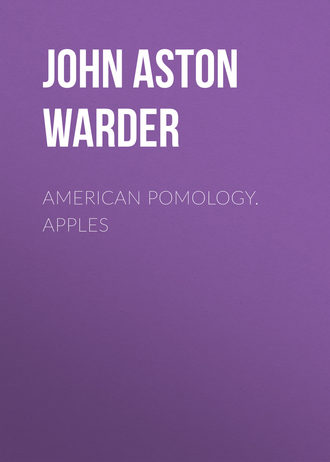 полная версия
полная версияПолная версия
American Pomology. Apples
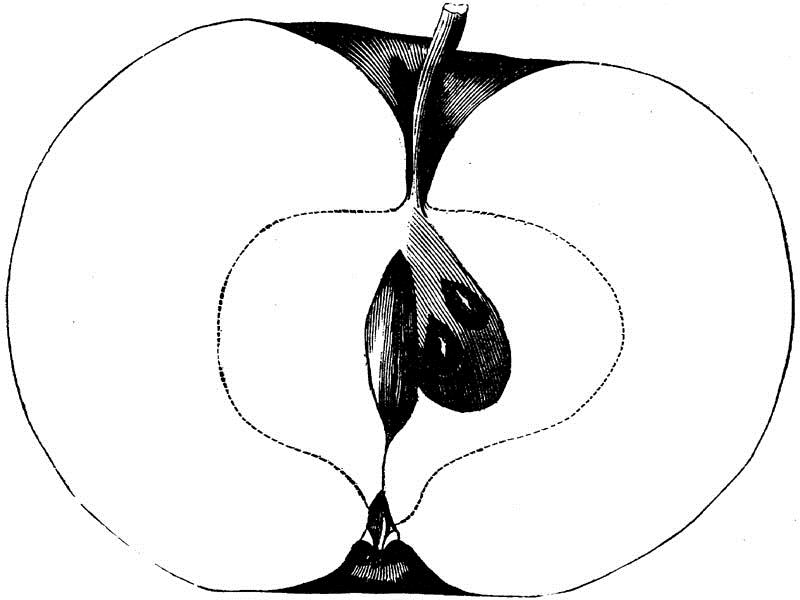
Fig. 187.—PARADISE WINTER SWEET.
Origin believed to be similar to its predecessor—Lancaster County, Pennsylvania.
Fruit large, globular, often unequal; Surface smooth, yellowish-white; Dots scattered, minute.
Basin abrupt, regular; Eye small, closed.
Cavity deep, acute, brown; Stem long, slender.
Core large, wide, open, clasping; Seeds plump and dark; Flesh white, tender, breaking, juicy; Flavor very sweet; Quality good; Use, baking and stock; Season, December to March.
Tallman's Sweet
Fig. 188.—TALLMAN'S SWEET.
This favorite baking apple of New England has traveled from Rhode Island wherever her hardy sons have gone westward.
Tree hardy, very productive.
Fruit medium to large, nearly round, somewhat flattened, regular; Surface smooth, yellow; Dots minute, dark; frequently a distinct line on one side from stem to eye.
Basin wide, regular, leather-cracked; Eye small, closed.
Cavity rather wide, regular; Stem medium size, long.
Core heart-shaped, regular, closed, clasping; Seeds numerous, plump, pointed, dark; Flesh yellow, breaking, firm; Flavor very sweet, rich; Quality good; Use, baking and stock; Season, December and January.
CLASS III.—ROUND APPLESORDER I.—REGULARSECTION 1.—SWEETSUB-SECTION 2.—STRIPEDBentley SweetThis long-keeping sweet apple was received in Eastern Ohio from some part of Virginia, where it is supposed to have originated.
Tree quite vigorous, upright while young, spreading, productive—an early bearer.
Fruit medium to large, globular, truncated, slightly flattened, regular; Surface smooth, yellow, or greenish, covered, mixed, blotched, striped and splashed dull red, becoming brighter when ripe; Dots minute.
Basin medium, abrupt, regular; Eye medium, open; Calyx reflexed.
Cavity deep, acute, regular; Stem slender, long.
Core round, flattened, regular, closed; Seeds numerous, plump, long; Flesh yellowish-white, firm, breaking, fine-grained; Flavor sweet; Quality good to very good; Season spring and all summer until September. Keeps sound.
Bowling SweetFrom Spottsylvania County, Virginia. Tree vigorous, very productive.
Fruit medium roundish, dull red on yellow; Flesh rich, juicy, sweet; Entirely free from acid; October to January.—[H.R. Robey, in Downing.]
CullasagaOrigin Macon County, North Carolina. Good grower; a standard winter fruit for the South.
Fruit medium or large, roundish, inclining to oval, flattened at base and crown, skin yellowish, mostly shaded and striped with dark crimson, and sprinkled with whitish dots; Stem small and short, inserted in a deep cavity, surrounded by russet; Calyx open, set in a shallow, corrugated basin; Flesh yellow, tender, juicy, with a very mild, rich, almost saccharine flavor. January to April.—[Downing.]
GilpinCARTHOUSE—LITTLE RED ROMANITE
Fig. 189.—GILPIN.
This valuable Virginia apple was cultivated and distributed by Coxe, and has found its way into the orchards and into favor all over the country, on account of its productiveness and early bearing.
Tree remarkably vigorous, strongly branched, spreading, open, round head, very productive; shoots stout, dark; foliage rather sparse, somewhat curled and glaucous.
Fruit medium, small on old trees, round, truncated at the ends, making it look cylindrical, mostly symmetrical, but large specimens often somewhat irregular; Surface very smooth, often polished, deep red all over, stripes indistinct; Dots minute, indented.
Basin wide, regular, or folded; Eye small, closed.
Cavity deep, acute, regular, brown; Stem very short.
Core medium, round, regular, closed; Seeds few, large, plump; Flesh greenish-yellow, firm, juicy; Flavor sweet, rich; Quality poor for dessert, though it is eatable in the spring—valuable for its cider from the richness of the must. Keeps sound until May—bruises do not rot as in other apples. Valuable also for stock.
Its early bearing makes it very desirable in a new country, and in the prairies it has received the soubriquet of "Dollars and Cents."
HallHALL'S SEEDLING—HALL'S RED
Fig. 190.—HALL.
From Franklin County, North Carolina, and now being spread throughout the Western States as a fruit of great promise.
Tree medium size, sufficiently thrifty, upright, hardy, very productive; Shoots long, rather slender, reddish, wood firm. Introduced into the West by the venerable R. Ragan, of Fillmore, Indiana. The specimens from which the following description was made were sent by J.S. Downer, of Elkton, Kentucky, from whom also my trees were obtained. Mr. J.P. Wilson, of Olney, Ill., says, it originated in Saline County, of that State, with Jonathan Hall, about forty years ago. [?]
Fruit small, round, slightly conical, regular; Surface smooth, yellow, covered with bright red, mixed and striped; Dots numerous, large, yellow.
Basin shallow, wavy or plaited, leather-cracked; Eye small, closed.
Cavity wide, regular, brown; Stem long, slender.
Core pyriform, regular, slightly open, clasping; Seeds large, plump; Flesh yellow, tender, fine-grained, juicy; Flavor sub-acid, rich, agreeable; Quality almost best; Use, table; Season, December to April.
Ladies' Sweeting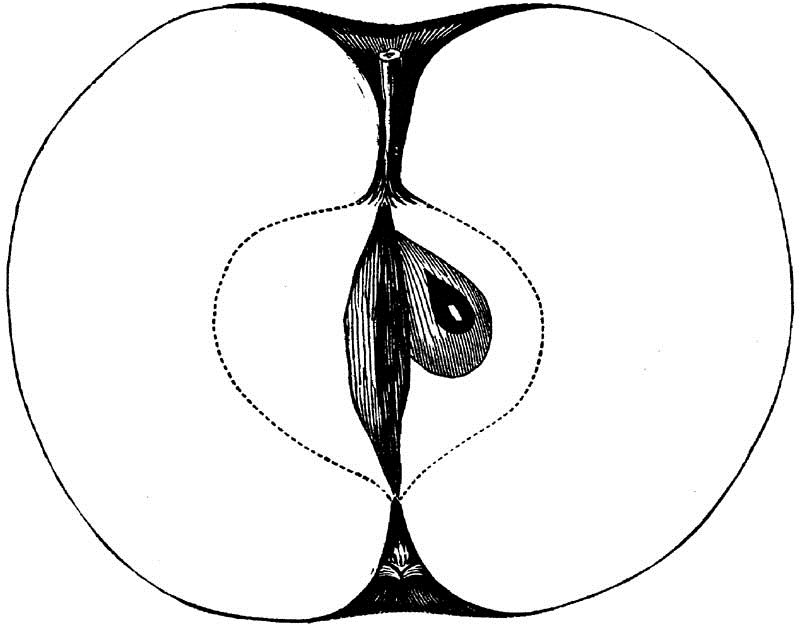
Fig. 191.—LADIES' SWEETING.
This prime favorite of Chas. Downing originated near Newburgh, New York. Though having many admirers, it finds strong competitors in the Broadwell, Paradise Winter, and some others of the same season.
Tree thrifty, productive.
Fruit large, round, somewhat conic, occasionally angular; Surface smooth, light yellow, striped and splashed with bright red; Dots distinct, large, gray.
Basin medium, often abrupt, folded; Eye very small, closed.
Cavity medium or wide, regular, brown; Stem short, or long and slender.
Core medium, round, closed or open, clasping; Seeds numerous (16), angular; Flesh white, crisp, fine-grained, juicy; Flavor sweet, agreeable; Quality only good (to my taste); Use, table, baking and stock feeding; Season, December.
Scarlet Sweet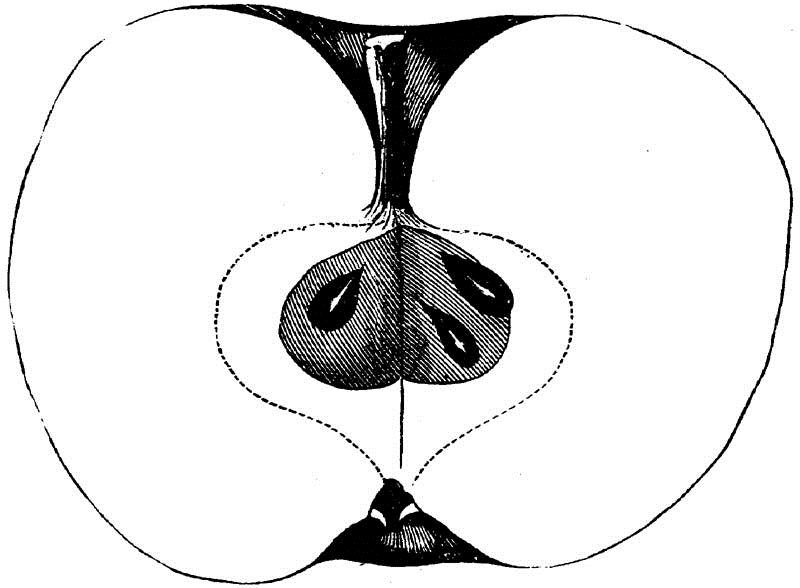
Fig. 192.—SCARLET SWEET.
This delicate fruit was received from my good friend Jas. Edgerton, of Barnesville, Ohio, who had exhibited it at the State Pomological Society at different times.
Fruit medium, round, somewhat flattened, regular; Surface smooth, yellow, striped and blushed scarlet; Dots minute.
Basin wide, abrupt, regular; Eye medium, open; segments short.
Cavity deep, acute, regular, brown; Stem medium, slender.
Core rather wide, regular, closed, clasping the eye; Seeds numerous, plump, angular; Flesh yellow, fine-grained, juicy; Flavor sweet; Quality good to very good; Uses, table, baking and market; Season, October to December.
This is different from the Scarlet Sweeting of Sigler, of Morgan County, Ohio—more like Hampton's Scarlet Sweet, of M.S. notes.
Sweet Janet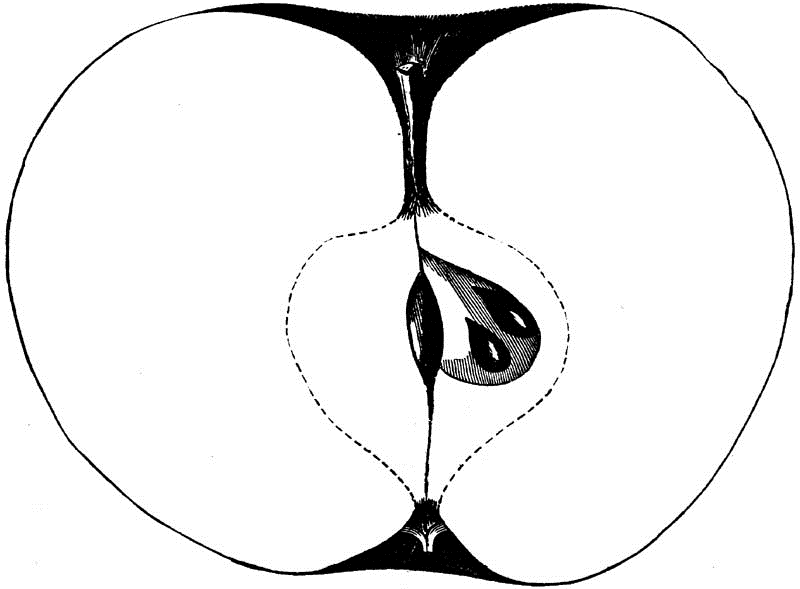
Fig. 193.—SWEET JANET.
This is another of the fine fruits originated by Reuben Ragan, of Indiana, from seed of Rawle's Janet. Tree large, healthy, vigorous, spreading; Shoots rather stout, brown; foliage rich green. Annually productive of fine, fair fruits, which are well distributed and hold well.
Fruit large, round, somewhat conical, regular; Surface smooth, covered with rich red or crimson, mixed and striped; Dots numerous, rather large, yellow, indented.
Basin regular or plaited; Eye medium, closed.
Cavity rather deep, very narrow, wavy; Stem quite short.
Core medium, turbinate, regular, slightly open, clasping; Seeds numerous, angular, pointed; Flesh yellow, breaking, juicy; Flavor very sweet; Quality good to very good; Use, baking, market; Season, December and January. Very profitable.
Sweet Romanite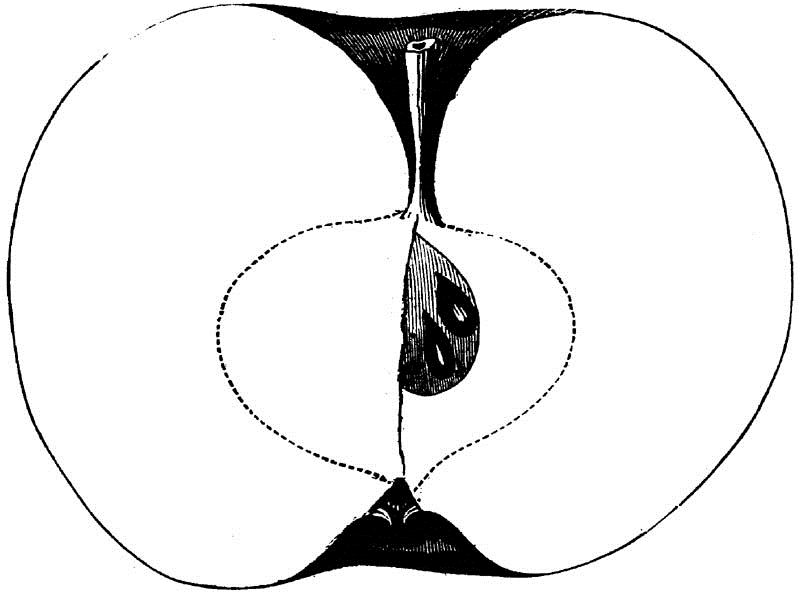
Fig. 194.—SWEET ROMANITE.
Origin unknown. Grown in Illinois; introduced at the State Society by the lamented Cyrus R. Overman, President—much esteemed by him.
Fruit medium, round, sometimes flattened or truncate, regular; Surface smooth, greenish-yellow, blushed, mixed bright red and dull red, stripes indistinct; Dots scattered, irregular, brown or fawn on the deeper colors.
Basin medium, or deep and abrupt, folded, plaited; Eye small, closed.
Cavity deep, acute, wavy, brown; Stem medium to long, green.
Core roundish, closed, clasping; Seeds numerous, plump, angular; Flesh yellow, fine-grained, breaking, juicy; Flavor very sweet; Quality good to very good; Use, baking, cider, table and stock; Season, December to April.
CLASS III.—ROUND APPLESORDER I.—REGULARSECTION 1.—SWEETSUB-SECTION 3.—RUSSETOrange Sweeting or RussetAn eastern variety—not much cultivated.
Fruit large, very round, regular; Surface greenish-yellow, bronzy-orange, russeted; Dots numerous, white, green bases.
Basin shallow, regular, or plaited; Eye small, closed.
Cavity acute, lipped, wavy; Stem short, green.
Core very large, turbinate, open, clasping; Seeds numerous, pointed, pale; Flesh green, rather tough, fine-grained, juicy; Flavor sweet; Quality good—for baking especially; Season, December.
Pumpkin RussetFruit large, globular, regular; Surface covered with coarse russeting; Flesh spongy, light, very sweet; Used for baking and apple butter; Season, autumn. Not valuable, except for stock.
CLASS III.—ROUND APPLESORDER I.—REGULARSECTION 2.—SOURSUB-SECTION 1.—SELF-COLORED OR BLUSHEDAshmore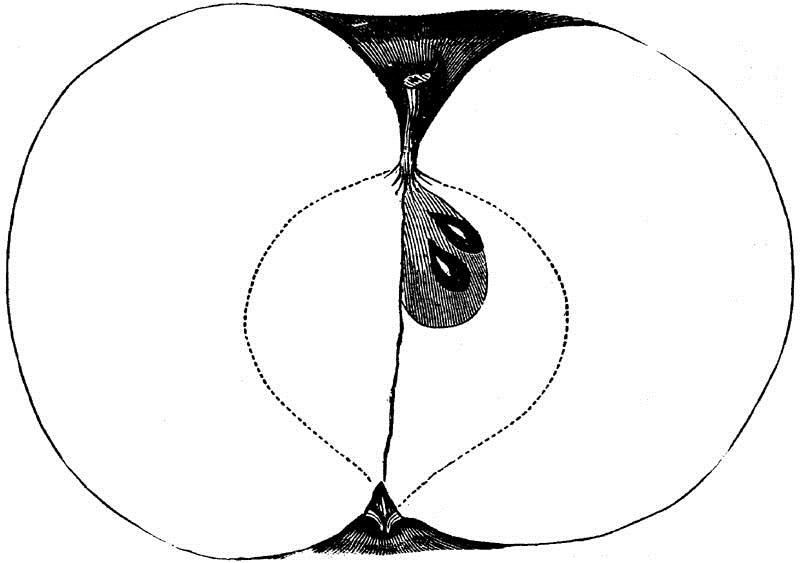
Fig. 195.—ASHMORE.
The origin of this fine dessert fruit is not known. Though not commonly cultivated, it is considerably scattered, and has come to me from several points in the West with different local names.
Tree vigorous, upright, with long parallel branches that become spreading. Shoots rather slender, foliage rich green.
Fruit rather large, handsome, round, frequently flattened, regular, rarely angular; Surface smooth, polished, very light waxen yellow, almost wholly covered with brilliant lively carmine, very rarely an indistinct stripe; Dots minute, gray, indented.
Basin medium, often wavy or even folded; Eye small, closed; Segments reflexed.
Cavity narrow, acute, regular or wavy; Stem medium to short.
Core indistinct, closed; Seeds plump; Flesh yellowish-white, crisp, tender, very fine-grained, juicy; Flavor sub-acid, very agreeable; Quality best, though not rich; Uses, table, kitchen and market; Season, September and October; May be kept into winter.
There is also a Striped Ashmore, resembling this in every respect, except in the distinct stripe. It is supposed to be a sport from the above. Both varieties have been propagated to some extent by suckers or sprouts.
BledsoeFrom Carroll County, Kentucky; Sent to Ohio by Lewis Sanders. Tree moderately vigorous, spreading, productive.
Fruit large, round, somewhat conical, flattened at the base, regular; Surface greenish-yellow.
Basin sometimes folded; Eye medium, closed.
Cavity deep, brown; Stem short.
Flesh white, fine-grained, crisp, juicy; Flavor mild sub-acid, agreeable; Quality good—Kentucky Horticultural Society say "very good;" Season, September to April.
Bush
Fig. 196.—BUSH.
Received from W.G. Waring, Tyrone, Pennsylvania. Supposed to be a seedling of Centre County. "Tree vigorous, hardy, thrifty, regularly productive."—[W.G.W.]
Fruit large, fair, round, regular; Surface smooth, waxy yellow, occasionally a faint blush; Dots minute, rare.
Basin wavy; Eye medium to small, closed.
Cavity deep, wavy, brownish; Stem long, slender, yellow.
Core medium, round, rather open, meeting the eye; Seeds few, plump, dark; Flesh whitish, tender, fine-grained, juicy; Flavor mild sub-acid, agreeable; Quality very good; Season August and September.
Mr. Waring considers it one of the best of the season, in which opinion I unite.
Cornish Aromatic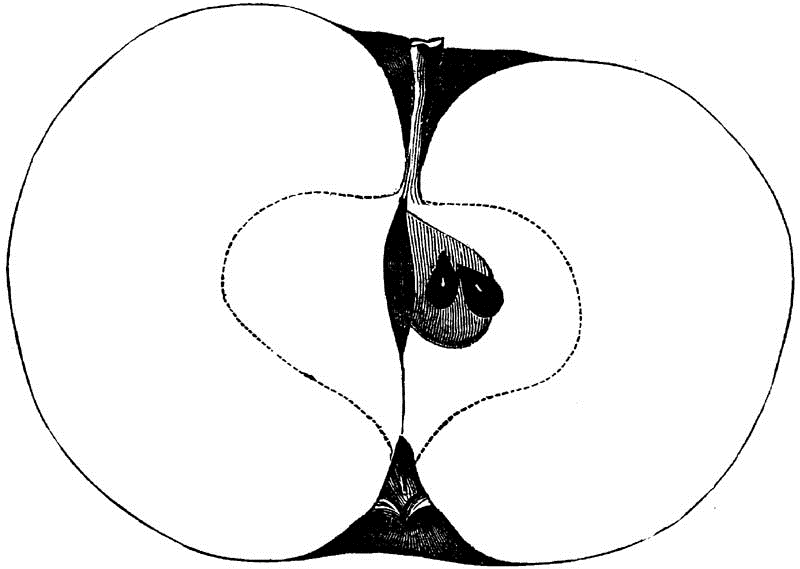
Fig. 197.—CORNISH AROMATIC.
This foreign variety was imported and tested at Louisville, Kentucky, by Mr. George Heinsohn, to whom I am indebted for specimens of other European varieties.
Fruit medium to large, roundish, a little flattened, regular; Surface smooth, yellow, washed rich red; Dots and spots yellow russet.
Basin medium, abrupt, regular or furrowed; Eye medium, closed.
Cavity medium depth, narrow; Stem medium to long, slender.
Core medium, somewhat open, clasping; Seeds large, plump, angular; Flesh yellow, breaking, juicy; Flavor sub-acid, aromatic, spicy; Season November to February.
Duffield Pippin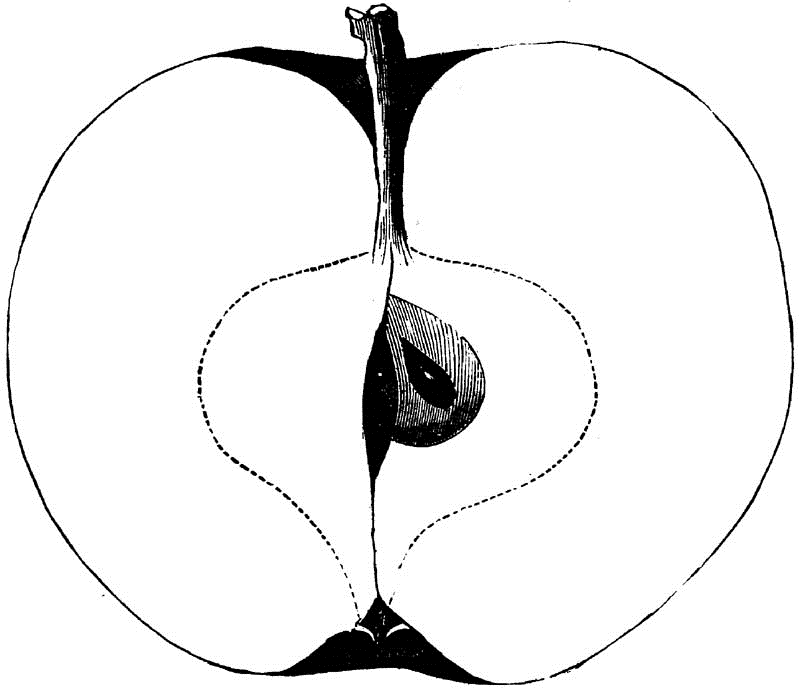
Fig. 198.—DUFFIELD PIPPIN.
Specimens from my friend T.T. Lyon, of Michigan, who says it is a seedling that originated in Pennsylvania, at the beginning of the present century, with the ancestors of Geo. Duffield, D.D., for whom it was named, when it received a first premium at the Michigan State Fair, as a valuable winter variety.
Fruit large, handsome, round, sometimes conic, regular; Surface smooth, yellowish-green, blushed; Dots scattered; minute, indented.
Basin abrupt, narrow, folded; Eye small, closed.
Cavity deep, narrow, acute; Stem medium to long.
Core closed, clasping; Seeds plump, brown; Flesh yellow, breaking, juicy; Flavor sub-acid; Quality good; Uses table, kitchen and market; Season January to April.
Fall Pippin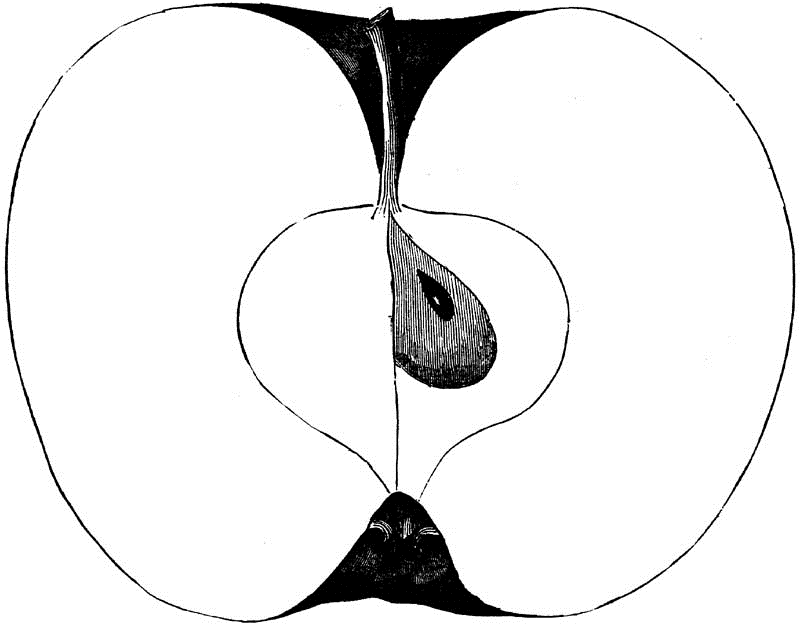
Fig. 199.—FALL PIPPIN.
It is unfortunate that since the days of Coxe there should have been a confounding of this noble and delicious American apple with the inferior foreign kitchen variety: the Holland Pippin.
Tree exceedingly vigorous, large, wide-branching, open head, not early bearer, moderately productive when old; Shoots stout, dark; Leaves large, broad.
Fruit large to very large, handsome, globular, truncated, making it cylindrical, regular; Surface smooth, rich yellow, rarely blushed South, frequently so North, with skin finer; Dots minute, gray.
Basin deep, abrupt, regular, marked with concentric rings which often crack open in large southern specimens; Eye large, open; Segments short.
Cavity wide, regular, or narrow, deep; Stem long.
Core large, regular, closed, meeting the eye; Seeds pointed, often imperfect; Flesh yellow, breaking, compact, very fine-grained; Flavor acid, becoming sub-acid, aromatic, delicious; Quality best for dessert, kitchen, market and drying; Season September to December.
Fall Swaar.—[Of the West.]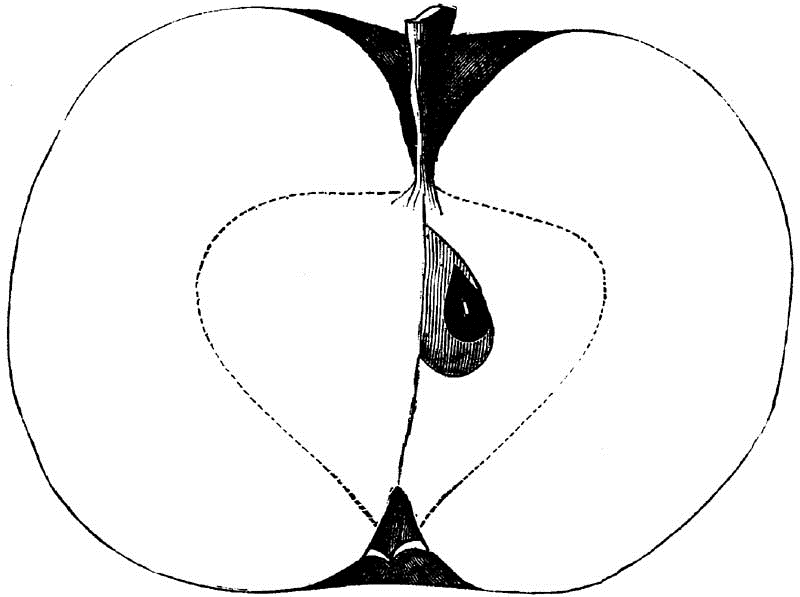
Fig. 200.—FALL SWAAR.
The origin of this apple is unknown. Like many others of our Western fruits, which have been received from various sources, and often from unreliable persons, and with wrong names, we have been obliged to re-christen this.
Fruit full medium to large, round, somewhat flattened, regular, handsome; Surface smooth, yellowish-green, with a bronzy blush; Dots numerous, large, gray.
Basin medium, regular; Eye small, closed.
Cavity medium, acute, regular, green; Stem medium to long, knobbed.
Core rather small, closed, clasping; Seeds numerous, large, plump; Flesh yellow, breaking, juicy; Flavor mild sub-acid, agreeable; Quality good; Uses table and kitchen; Season September.
Gloucester WhiteThis Virginia apple was highly prized by Coxe for its qualities as a cider fruit. Not having seen it, his description is quoted:
"This apple is of middling size, of a shape not very uniform, varying from oblong to flat; the color when ripe is a bright yellow, with clouds of black spots; the flesh is yellow, rich, breaking, and juicy; of a fine flavor as a table apple, and producing cider of an exquisite taste. The stalk is of the ordinary length, inserted in a cavity of medium depth; the crown is moderately deep. The time of ripening is about the first of October, after which the fruit soon falls and is fit for cider. It does not keep long, but while in season is a delicious table apple. The tree is very thrifty, hardy and vigorous, of a regular and beautiful form, and very productive. It is much cultivated in the lower counties of Virginia, from whence I procured it, as an apple of high reputation."
Horse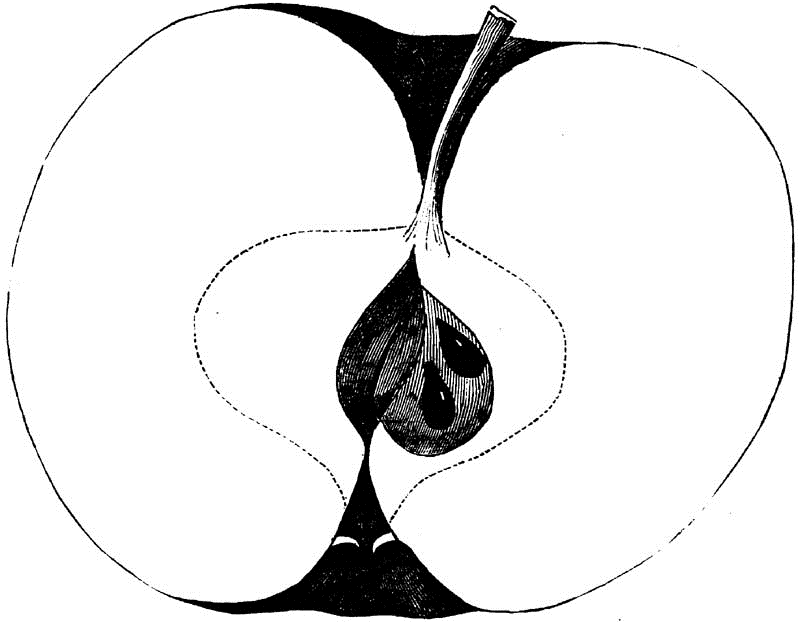
Fig. 201.—HORSE.
Another southern favorite, much liked by its western cultivators, especially as a useful family apple.
Fruit large, round, somewhat conical, truncated, uneven; Surface yellow; Dots scattered, indented, large, gray and greenish.
Basin abrupt, folded; Eye medium, closed.
Cavity deep, acute, wavy, brown; Stem medium to long.
Core large, somewhat open, clasping; Seeds numerous, medium, plump, brown; Flesh yellow, breaking, fine, juicy; Flavor sub-acid; Quality good; Use, kitchen, market and drying; Season, August, September.
Hunge
Fig. 202.—HUNGE.
This southern apple was received from Mr. S.W. Westbrooke, Greensboro', North Carolina.
Fruit large, round, somewhat flattened, regular; Surface smooth, greenish-yellow, blushed; Dots scattered, white.
Basin regular, abrupt; Eye small, closed, very long; Calyx reflexed.
Cavity wide, wavy; Stem short, slender.
Core large, wide, irregular, open, clasping; Seeds numerous, angular, plump; Flesh white, fine-grained, tender, juicy; Flavor sub-acid, mild; Quality pretty good; Use, table, kitchen, drying; Season, September.
KnickerbockerSpecimens from W.S. Carpenter, New York.
Fruit above medium, roundish, conic, unequal; Surface smooth, greenish-yellow; Dots numerous, minute, distinct, whitish, indented.
Basin abrupt, wavy, folded; Eye medium, closed.
Cavity wide, wavy, brown; Stem long, slender, green.
Core very wide, closed, clasping the eye; Axis short; Seeds angular, pale; Flesh greenish-yellow, tender, fine-grained, juicy; Flavor sub-acid, rich, very agreeable; Quality best; Use, table, kitchen; Season, October.
Long Island PippinOrigin unknown. Specimens received from T.T. Lyon, Plymouth, Michigan.
Fruit large, roundish, flattened, regular; Surface smooth yellowish-green; Dots minute, scattered.
Basin abrupt, deep, regular; Eye medium, closed.
Cavity medium, regular, green; Stem medium to long.
Core large, oval, closed, clasping; Seeds numerous, pointed, angular, pale; Flesh greenish-yellow, breaking, fine-grained, juicy; Flavor sub-acid; Quality almost best; Use, table; Season, January.
LowellTALLOW PIPPIN, QUEEN ANNE, &COrigin unknown.
Tree vigorous, healthy, round-headed; Foliage yellowish green.
Fruit large, round, slightly conic, truncated, regular; Surface smooth, waxy yellow, not blushed or bronzed, becoming greasy when kept indoors; Dots numerous, green.
Basin deep, abrupt, regular; Eye medium, closed.
Cavity medium, regular, green; Stem long, slender.
Core medium, oval, closed, clasping; Seeds numerous, angular, pointed, pale; Flesh yellow, tender, fine-grained, juicy; Flavor sub-acid, aromatic; Quality very good; Use, table, cooking, drying, market; Season, August, September.
McAdow's June.—[Local Name.]Specimens received from Chillicothe, Ohio. Thought at one time to be Tetofski, but the descriptions do not correspond.
Fruit medium to small, globular, slightly conical, regular; Surface smooth, greenish, yellow, blushed; Dots numerous, large, white.
Basin medium, wavy; Eye small, closed.
Cavity rather wide, regular; Stern long, stout.
Core small, round, closed, not meeting the eye; Seeds numerous, brown; Flesh yellow, tender, fine-grained, juicy; Flavor sub-acid; Use, kitchen, table; Quality good; Season, June, July; one of the earliest.
Pomologists have been in doubt whether this may not be the Tetofski. Comparison should be made of the tree characters.
Michigan Golden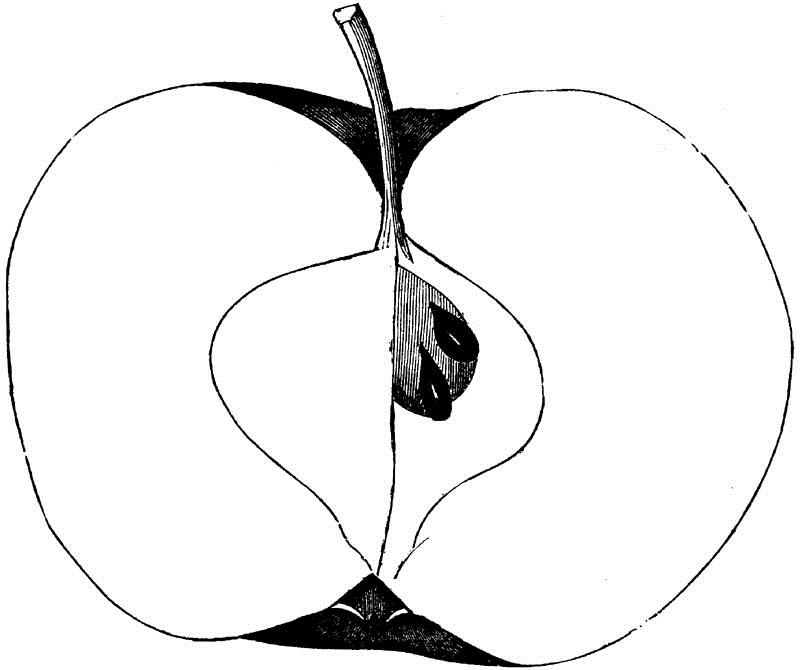
Fig. 203.—MICHIGAN GOLDEN.
This beautiful apple was received from the accurate pomologist, T.T. Lyon, of Plymouth.
Fruit large, globular, slightly conic, truncated and somewhat angular; Surface smooth, becoming greasy, greenish yellow; Dots minute, prominent.
Basin abrupt, folded; Eye small, closed.
Cavity wide, wavy; Stem long, inclined.
Core medium, closed, clasping; Seeds numerous, long, pointed; Flesh yellow, breaking, juicy; Flavor sub-acid; Quality nearly best; Use, table, kitchen; Season, September to November.
Monmouth PippinRED CHEEK
Fig. 204.—MONMOUTH PIPPIN.
Fruit rather large, handsome, roundish or flattened, regular; Surface smooth, greenish yellow, blushed and marbled; Dots minute, green.
Basin shallow, regular; Eye large, closed.
Cavity wide, regular or wavy, brown; Stem short, thick.
Core medium, closed, clasping; Seeds numerous, pointed, brown; Flesh white, breaking, fine-grained, juicy; Flavor acid; Quality good for cooking only; Season, December to February.
Newtown PippinGREEN NEWTOWNThis is probably the original Newtown Pippin, but by no means the more common, which is the Yellow Newtown Pippin, to be described in another place.
Fruit medium to large, globular, flattened, sometimes obscurely ribbed; Surface smooth, green, becoming yellowish green when fully ripe, sometimes bronzy, and always showing white irregular striæ near the base when first gathered; Dots scattered, minute, dark.
Basin shallow, folded; Eye small, closed.
Cavity wide, wavy, brown; Stem long, slender.
Core round, regular, closed, meeting the eye; Seeds pointed, plump, dark; Flesh greenish white, crisp, tender, juicy; Flavor acid, aromatic, rich, very agreeable; Quality best; Use, dessert, cooking; Season, December to March.
Roman Stem
Fig. 205.—ROMAN STEM.
Origin Burlington, New Jersey. Tree moderately vigorous, very productive.
Fruit medium, globular, regular; Surface smooth, yellow, often blushed; Dots minute, dark.
Basin shallow, regular, or wavy, russet; Eye small, closed.
Cavity acute, lipped; Stem long.
Core rather large, heart-shaped, regular, clasping; Seeds numerous, plump; Flesh yellowish white, fine-grained, juicy; Flavor mild sub-acid, rich; Quality good to very good; Use, table; Season, December, January.
Royal PearmainWe have two different apples bearing this name, both very promising and desirable sorts. I shall, in this place, attempt to describe the one mentioned by Coxe, as my specimens are traced back to his nursery, though coming to the West by way of Georgia.
Fruit full medium to large, globular, rather flattened, regular; Surface not smooth, of a rich yellow, finely blushed, with carmine more or less diffused over the fruit, and overspread with a very thin russet; Dots medium, prominent, brown.



